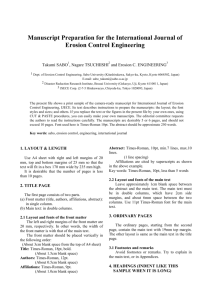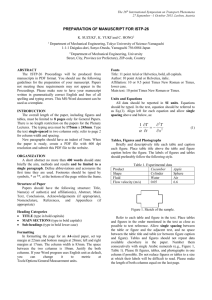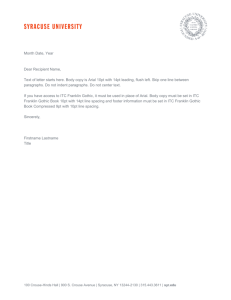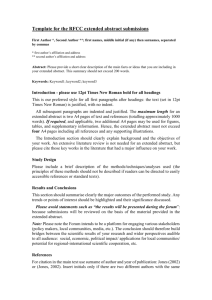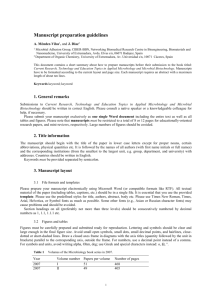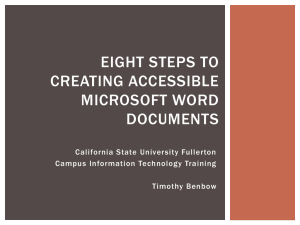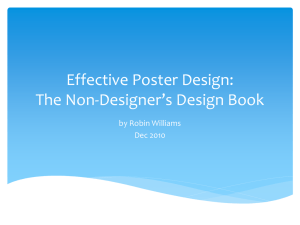template - ICSE-4
advertisement
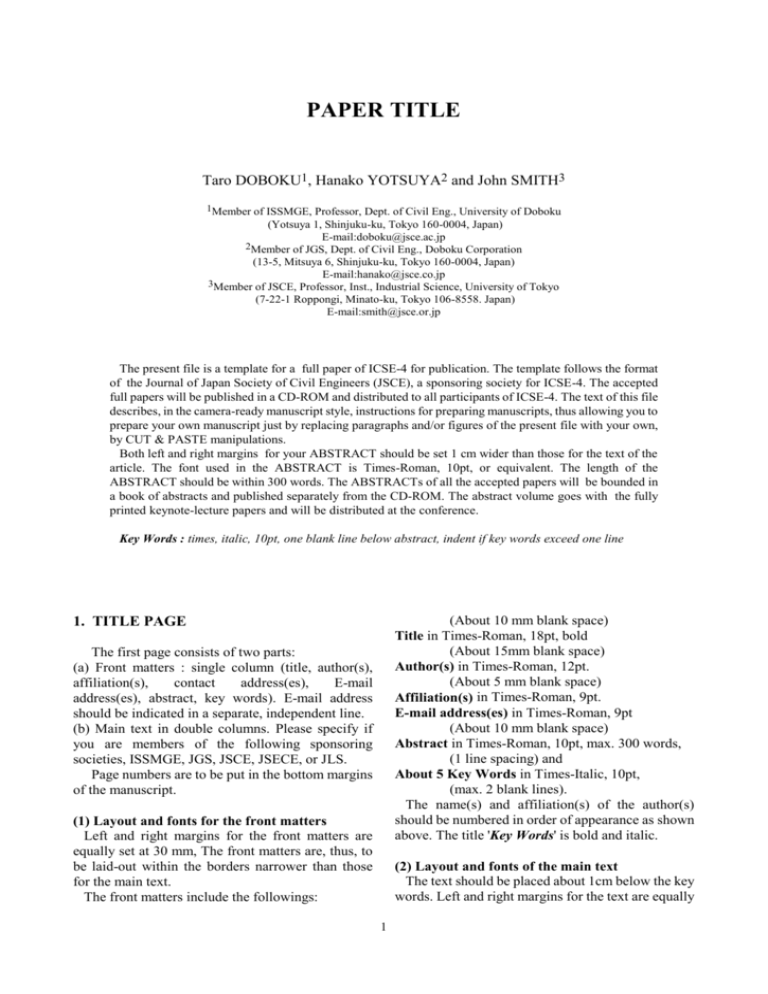
PAPER TITLE Taro DOBOKU1, Hanako YOTSUYA2 and John SMITH3 1Member of ISSMGE, Professor, Dept. of Civil Eng., University of Doboku (Yotsuya 1, Shinjuku-ku, Tokyo 160-0004, Japan) E-mail:doboku@jsce.ac.jp 2Member of JGS, Dept. of Civil Eng., Doboku Corporation (13-5, Mitsuya 6, Shinjuku-ku, Tokyo 160-0004, Japan) E-mail:hanako@jsce.co.jp 3Member of JSCE, Professor, Inst., Industrial Science, University of Tokyo (7-22-1 Roppongi, Minato-ku, Tokyo 106-8558. Japan) E-mail:smith@jsce.or.jp The present file is a template for a full paper of ICSE-4 for publication. The template follows the format of the Journal of Japan Society of Civil Engineers (JSCE), a sponsoring society for ICSE-4. The accepted full papers will be published in a CD-ROM and distributed to all participants of ICSE-4. The text of this file describes, in the camera-ready manuscript style, instructions for preparing manuscripts, thus allowing you to prepare your own manuscript just by replacing paragraphs and/or figures of the present file with your own, by CUT & PASTE manipulations. Both left and right margins for your ABSTRACT should be set 1 cm wider than those for the text of the article. The font used in the ABSTRACT is Times-Roman, 10pt, or equivalent. The length of the ABSTRACT should be within 300 words. The ABSTRACTs of all the accepted papers will be bounded in a book of abstracts and published separately from the CD-ROM. The abstract volume goes with the fully printed keynote-lecture papers and will be distributed at the conference. Key Words : times, italic, 10pt, one blank line below abstract, indent if key words exceed one line (About 10 mm blank space) Title in Times-Roman, 18pt, bold (About 15mm blank space) Author(s) in Times-Roman, 12pt. (About 5 mm blank space) Affiliation(s) in Times-Roman, 9pt. E-mail address(es) in Times-Roman, 9pt (About 10 mm blank space) Abstract in Times-Roman, 10pt, max. 300 words, (1 line spacing) and About 5 Key Words in Times-Italic, 10pt, (max. 2 blank lines). The name(s) and affiliation(s) of the author(s) should be numbered in order of appearance as shown above. The title 'Key Words' is bold and italic. 1. TITLE PAGE The first page consists of two parts: (a) Front matters : single column (title, author(s), affiliation(s), contact address(es), E-mail address(es), abstract, key words). E-mail address should be indicated in a separate, independent line. (b) Main text in double columns. Please specify if you are members of the following sponsoring societies, ISSMGE, JGS, JSCE, JSECE, or JLS. Page numbers are to be put in the bottom margins of the manuscript. (1) Layout and fonts for the front matters Left and right margins for the front matters are equally set at 30 mm, The front matters are, thus, to be laid-out within the borders narrower than those for the main text. The front matters include the followings: (2) Layout and fonts of the main text The text should be placed about 1cm below the key words. Left and right margins for the text are equally 1 Table 1 Caption should be centered, but if it is long, it should be indented like this. set at 20 mm. The text, in double columns put side by side with 6 mm gap in between, must be singlespaced with double spacing between chapters. The first line of each paragraph is indented 3 spaces. Use 11pt Times-Roman font for the text. Specimen No. 1 2 3 (3) page number Page numbers should be center-aligned and should appear at the bottom of each page. Heights (m) Width (m) 1.45 1.75 1.90 0.25 0.40 0.65 25 20 Counts 2. ORDINARY PAGES In ordinary pages, the text must be placed within borders immediately below 19mm top margin. The other layout is same as the main text in the title page. 15 Case 2 10 Case 1 5 0 0 (1) Footnotes and remarks Avoid using footnotes and/or remarks. If any, try to explain it in the text, or in appendices. 2 4 6 Events Fig.2 Place the caption below the drawing. 3. HEADINGS (INDENT LIKE THIS SAMPLE IF IT IS LONG) F sin z dz (1) Main heading Capital letters in 12pt bold face fonts should be used for main headings (chapter titles) that follow the chapter numbers as is shown in this example. Leave double and single spacing of lines before and after every main heading. and some appear in the text as C D , z . If their quality is not satisfactory, the manuscript may not be accepted. Numbered equations ((1a) and (1b) for example) should be center-aligned. The equation numbers in parentheses should be placed flush right. (2) Sub-headings for sections The sub-headings for sections, in 10pt. bold face fonts, with their initial letters capitalized, are preceded by parenthesized section number like (2). Leave single spacing of line before every sub-heading. a) Sub-headings for sub-sections They are written just as the sub-headings for sections are done, but follow alphabets with right parentheses. No spacing of lines is left before and after every sub-heading. 5. FIGURES AND TABLES (1) Location of figures and tables Figures, tables and photographs should be inserted at the upper or lower part of the page where reference is first made to them. Do not place them altogether at the end of the manuscript. Figures or tables should occupy the whole width of a column, as shown in Table 1 or Fig.2 in this example, or the whole width over two columns. Do not place any text besides figures or tables. Insert about one to two lines spacing above the main text. Since the paper is published in CD-ROM, figures can use any colors. 4. MATHEMATICS Use special high quality fonts for all mathematical equations in the text. Some equations may be placed off the text as: (2) Fonts and captions Do not use too small characters in figures and tables. At least, the letters should be larger than those in the captions (9 pt). Captions should be centered, but long captions must be indented like an example G bn t (1b) (1a) n0 2 2) Miche, M. : Amortissement des houles dans le do-maine de l’eau peu profonde, La Houile Blanche, No. 5, pp. 726-745, 1956. 3) Gresho, P. M., Chan, S. T., Lee, R. L. and Upson, C. D. : A modified finite element method for solving the timedependent incompressible Navier-Stokes equations, part 1, Int. J. Numer. Meth. Fluids, Vol. 4, pp. 557-598, 1984. 4) Shepard, F. P. and Inman, D. L. : Nearshore water circulation related to bottom topogrphy and wave refraction, Trans. AGU., Vol. 31, No. 2, 1950. 5) Smith, W., et al : Cellular phone positioning and travel times estimates, Proc. of 8th ITS World Congress, CD-ROM, 2000.Dean, R. G. : Stream function representation of nonlinear ocean waves, J. Geophys. Res., vol.70, pp.4561-4572, 1965. 6) Liu, P. L. -F. and Hsu, T. -J. : Modeling cross-shore sediment transport using two-phase flow approach, Proc. Int. Conf. on Coast. Sed. 2003, CD-ROM, 2003. 7) Miche, M. : Amortissement des houles dans le do-maine de l’eau peu profonde, La Houile Blanche, No. 5, pp. 726-745, 1956. 8) Miles, J. W. : On the generation of surface waves by shear flows, J. Fluid Mech., Vol. 3, Pt. 2, pp. 185-204, 1957. 9) de Vriend, H.J. and Barends, F.B.J.: Scour and erosion: common ground between hydraulics and geotechnics, Proc. 3rd Int. Conf. on Scour and Erosion, Amsterdam, pp. 45-51, 2006. 10) Wiegel, R.L. : Oceanographical Engineering, Prentice-Hall, Englewood Cliffs, New Jersey, 531 pp., 1965. of Table 1. The heading of captions is 9pt bold face. 6. CITATION AND REFERENCE LIST All the references must be numbered in the order of appearance in the article and the right parenthesized numbers are used at the text where it is referred like this1). The reference list must be summarized at the end of the main text. Use 9pt font for the list. ACKNOWLEDGMENT: Acknowledgment should follow Conclusions and its text should be preceded by bold face heading directly. APPENDIX A APPENDIX Appendix should be placed between Acknowledgment and References. REFERENCES 1) Miles, J. W. : On the generation of surface waves by shear flows, J. Fluid Mech., Vol. 3, Pt. 2, pp. 185-204, 1957. 3
![[Original Paper]](http://s3.studylib.net/store/data/006858232_2-ac08fe56832330847bdefc78f867e12b-300x300.png)
![[Original Paper]](http://s3.studylib.net/store/data/007378360_1-d1f3b9477047b18096b855c383531b19-300x300.png)
